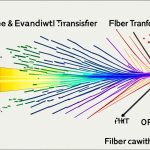Fiber to the Home (FTTH) networks have revolutionized broadband connectivity, offering faster and more stable internet connections. As the demand for high-bandwidth applications continues to grow, FTTH technology provides superior speed, reliability, and future-proof solutions for Canadian homes. From streaming services to online gaming and remote work, FTTH meets the data-intensive needs of modern society.
With its utilization of optical fibers for data transmission, FTTH has rapidly transformed internet infrastructure in the U.S., bridging the digital divide and ensuring equitable connectivity. It outshines traditional copper and coaxial cable networks, providing unmatched performance and enhancing the overall quality of life.
The Evolution of FTTH Technology
The evolution of FTTH technology since the 1980s has been driven by the increasing demand for higher internet speeds. Fiber optic cables, which offer higher bandwidth and lower signal loss than traditional copper wires, were initially used for long-distance telephone signaling.
FTTH emerged as a concept in the late 1990s and early 2000s, bringing fiber optic cables directly to homes and businesses for unprecedented internet speeds. This groundbreaking technology revolutionized internet connectivity, providing faster and more reliable connections for users.
The 2010s witnessed rapid FTTH deployment due to significant technological advancements and cost-effectiveness. Fiber optics became more accessible, leading to increased network infrastructure development across the globe. This expansion played a pivotal role in meeting the growing demands of data-intensive activities such as streaming high-definition content, online gaming, and telecommuting.
FTTH has become a critical infrastructure supporting the data needs of modern society. Its high-speed capabilities enable seamless streaming of high-quality video content, empower smart homes with advanced automation, and lay the foundation for smart cities to thrive. This technology has revolutionized the way we communicate, work, and access information.
The Advantages of Fiber Optics
Compared to traditional copper wires, fiber optics offer numerous advantages that make them the preferred choice for high-speed internet connectivity:
- Superior Speed: Fiber optic cables provide faster internet speeds, enabling seamless streaming, downloading, and uploading of large files.
- Higher Bandwidth: Fiber optics have a higher bandwidth capacity, allowing for multiple users to simultaneously access high-speed internet without experiencing a decrease in performance.
- Reduced Signal Loss: Fiber optic cables have lower signal loss compared to copper wires, resulting in more reliable and consistent internet connections.
- Greater Stability: Fiber optics are not susceptible to electromagnetic interference, ensuring a stable internet connection even in environments with electrical noise.
- Longer Reach: Fiber optic cables can transmit data over longer distances before requiring regeneration, making them ideal for long-distance communications.
With these advantages, fiber optics have transformed the landscape of internet connectivity, enabling users to enjoy faster, more reliable, and future-proof internet speeds.
The Road Towards a Faster Future
As technology continues to advance, FTTH technology is poised to play a vital role in meeting the increasing demands for higher internet speeds. The ongoing development and deployment of FTTH networks are paving the way for a faster, more connected future.
| Advantages of FTTH Technology | Advantages of Copper Wires |
|---|---|
| Superior speed for high-bandwidth applications | Lower cost of installation and maintenance |
| Reliable and stable internet connections | Widely available infrastructure |
| Unlimited bandwidth potential | Compatibility with existing infrastructure |
With its unrivaled speed, reliability, and potential for unlimited bandwidth, FTTH technology is leading the way in transforming the digital landscape. As internet needs continue to evolve and expand, FTTH networks will be at the forefront, providing the connectivity necessary to support the data-intensive demands of modern society.
The Growth and Expansion of FTTH
FTTH adoption has experienced significant growth in the U.S., outpacing traditional broadband networks in terms of speed and efficiency. This growth is not limited to urban areas, as rural regions are also benefiting from FTTH, reducing the digital divide.
FTTH provides ultra-high-speed internet necessary for data-heavy activities like streaming, online gaming, and telecommuting. Its implementation fosters new opportunities in education, healthcare, and business, enhancing the overall quality of life. FTTH is a catalyst for social and economic transformation, driving the U.S. towards a more connected and digitally inclusive future.

Benefits of FTTH in Rural Regions
In rural areas, the availability of reliable and high-speed internet has historically been limited. With the expansion of FTTH, rural regions are now able to bridge the digital divide and gain access to the same quality of internet service as their urban counterparts.
Rural communities can now enjoy faster download and upload speeds, enabling them to participate in various online activities without limitations. Streaming high-definition content, engaging in online gaming, and working remotely have become feasible options for residents in remote areas.
FTTH adoption in rural regions is a game-changer, enabling individuals and businesses to unleash their full digital potential and participate in the modern economy.
Impact on Education and Healthcare
The availability of FTTH in rural regions has had a profound impact on education and healthcare services. Students in remote areas can now access online learning resources seamlessly, empowering them with equal educational opportunities.
In healthcare, FTTH enables telemedicine, allowing patients in rural areas to connect with healthcare providers digitally. This eliminates the need for long-distance travel, particularly for routine check-ups and follow-up appointments.
Business Opportunities in Rural Areas
FTTH infrastructure in rural areas also opens up new business opportunities. It facilitates the growth of remote work and entrepreneurship, creating jobs locally and reducing the need for individuals to migrate to urban areas in search of employment.
Small businesses in rural regions can now leverage FTTH to expand their market reach, engage in e-commerce, and access digital tools and platforms. This level of connectivity and access to online markets promotes economic growth and reduces the urban-rural divide.
Driving Innovation and Development
FTTH adoption in both urban and rural regions drives innovation and technological development. The availability of high-speed internet encourages the creation of new digital services, applications, and technologies. This fosters a competitive digital ecosystem that contributes to national economic growth.
FTTH is not just about faster internet; it is about creating a foundation for future innovations and advancements across various sectors.
As FTTH continues to expand and reach more communities, the divide between urban and rural regions is being narrowed. The growth and adoption of FTTH technology are essential for empowering individuals, fostering economic development, and ensuring equitable access to the opportunities provided by the digital age.
Understanding FTTH Technology
In the world of high-speed internet connectivity, Fiber-To-The-Home (FTTH) technology is a game-changer. It leverages fiber optic communication to establish a direct connection from the main telecommunications switch to residential and commercial properties, ensuring unmatched speed and reliability.
Compared to other FTTx (Fiber-To-The-X) technologies like FTTB (Fiber-To-The-Building), FTTN (Fiber-To-The-Node), and FTTC (Fiber-To-The-Cabinet), FTTH offers superior performance. While these technologies use different connection points and cabling techniques that result in slower speeds, FTTH’s direct fiber connection enables faster and more efficient data transmission.
FTTH not only delivers high-speed internet but also provides unparalleled reliability. Fiber optic cables have higher resistance to signal loss and interference, ensuring a stable connection even during peak usage periods. This reliability is essential for data-intensive activities such as streaming, online gaming, and remote work.
Beyond its speed and reliability, FTTH is future-ready. The ever-increasing demand for bandwidth requires a scalable infrastructure, and FTTH meets this requirement. With its fiber optic infrastructure, FTTH can accommodate the evolving needs of high-speed internet access, making it the preferred choice for both residential and commercial users.

FTTH brings numerous benefits to users, ensuring they can fully leverage the potential of high-speed internet. Whether it’s streaming high-definition content, utilizing cloud services, or embracing emerging technologies like virtual reality, FTTH empowers users with seamless and reliable internet connectivity for all their digital needs.
Benefits of FTTH over Coax and DSL
When it comes to high-speed internet access, Fiber-To-The-Home (FTTH) has significant advantages over traditional coaxial and DSL connections. Let’s explore the key benefits that make FTTH the preferred choice for modern internet demands.
Superior Speed for Modern Internet Demands
FTTH offers unparalleled speed, enabling gigabit connections that are essential for today’s data-intensive applications. Whether you’re streaming high-definition content, engaging in online gaming, or conducting video conference calls, FTTH provides the bandwidth necessary for a seamless and lag-free experience.
Reliable Connection with Minimal Interference
Compared to copper-based networks like coaxial and DSL, FTTH offers a more reliable connection with less signal degradation and interference. The use of fiber optic cables eliminates the risk of electromagnetic interference and ensures consistent and stable internet connectivity, even during peak usage hours.
Lower Maintenance and Extended Lifespan
The durability of fiber optic cables contributes to lower maintenance requirements and an extended lifespan compared to traditional copper cables. Fiber networks are less susceptible to physical damage and weather-related issues, resulting in reduced maintenance costs and a more resilient infrastructure.
Future Compatibility and Scalability
FTTH is future-proof and designed to support the evolving internet technologies and bandwidth needs of tomorrow. As new applications and services emerge, FTTH can effortlessly accommodate the increased bandwidth requirements, ensuring a seamless user experience without the need for infrastructure upgrades.
FTTH Deployment Strategies and Challenges
Successful deployment of Fiber-To-The-Home (FTTH) networks requires careful planning and execution. Service providers face various logistical challenges that must be overcome to ensure timely and cost-effective rollouts. Additionally, community engagement plays a crucial role in gaining local support and minimizing disruptions. Let’s explore the key strategies and challenges in FTTH deployment.
Logistical Challenges
FTTH deployment is not without its logistical hurdles. Service providers often encounter supply chain disruptions, which can delay the delivery of essential equipment and materials. Additionally, the diverse terrain, especially in rural areas, poses challenges in laying fiber optic cables. Overcoming these challenges requires efficient supply chain management and expert coordination.
Effective Deployment Strategies
To ensure the seamless expansion of FTTH networks, service providers must adopt effective deployment strategies. These strategies involve careful planning, efficient resource allocation, and leveraging existing infrastructure:
- Thorough Network Design: Proper network design is crucial in determining the most efficient and cost-effective way to deploy FTTH infrastructure. It involves feasibility studies, route planning, and considering future expansion needs.
- Utilization of Existing Infrastructure: Leveraging existing infrastructure, such as utility poles and underground conduits, can help reduce costs and accelerate deployment. Cooperation with other utility companies can streamline the installation process.
- Skilled Workforce: Building a skilled workforce or collaborating with experienced third-party contractors ensures the efficient execution of the deployment plan. Trained technicians and engineers are essential for performing the intricate tasks involved in installing and maintaining FTTH networks.
- Government Collaboration: Collaboration with local authorities and government agencies is necessary to navigate regulations, obtain permits, and address potential legal or bureaucratic challenges. Building strong partnerships with the government enhances the success and expediency of network deployment.
Community Engagement
Engaging the local community is essential for the smooth integration of FTTH infrastructure. Collaborating with residents, local authorities, and businesses fosters a positive environment and reduces resistance or opposition. Service providers should educate the community about the benefits of FTTH, address concerns, and ensure minimal disruptions during the deployment process.
“By involving the community in the FTTH deployment process, we can create a sense of ownership and foster a positive digital transformation experience.”
Community engagement strategies may include:
- Hosting town hall meetings or public forums to address questions and concerns
- Proactive communication through newsletters, website updates, and social media platforms
- Working with local organizations and community leaders to ensure inclusivity and representation
- Forming partnerships with local businesses to facilitate access and enable adoption
Conclusion
Proper design and deployment considerations are paramount for the success and efficiency of FTTH networks. When implementing FTTH projects, key factors such as skilled labor, existing infrastructure, integration with existing and future networks, and government regulations must be taken into account.
Building a skilled labor force or partnering with experienced third-party designers ensures the successful execution of the network architecture. The expertise and knowledge of these professionals contribute to the proper design and implementation of FTTH networks, ensuring efficient and reliable connectivity.
It is also important to utilize existing infrastructure whenever possible. By leveraging and integrating with the existing network infrastructure, costs can be reduced, allowing for a more cost-effective deployment of FTTH networks. Furthermore, standardizing components across multiple FTTH projects promotes efficiency and streamlines operations.
Compliance with government regulations is crucial to ensure seamless connectivity and future-proof infrastructure. Adhering to regulatory requirements guarantees that FTTH networks are in line with industry standards and can adapt to future developments and advancements in technology.
By considering these factors – skilled labor, existing infrastructure, integration, and compliance – FTTH networks can thrive and deliver high-speed connectivity to Canadian homes. As technology continues to evolve, it is essential to prioritize proper design and deployment considerations to create robust and reliable networks that meet the connectivity needs of the future.
FAQ
What is FTTH technology?
FTTH, or Fiber-To-The-Home, is a type of fiber optic communication that extends from the main telecommunications switch directly to homes or businesses, providing unmatched high-speed internet connectivity through a direct fiber connection.
How does FTTH differ from other FTTx technologies?
FTTH differs from other FTTx technologies like FTTB, FTTN, and FTTC, which use different connection points and cabling techniques that result in slower speeds. FTTH offers superior speed, reliability, and future compatibility, making it the preferred choice for high-speed internet access.
What are the advantages of FTTH over coax and DSL connections?
FTTH offers several advantages over coaxial and DSL connections. It provides superior speed, enabling gigabit speeds essential for modern internet demands. FTTH also offers a more reliable connection, with less signal degradation and interference compared to copper-based networks. The durability of fiber optic cables results in lower maintenance requirements and a longer lifespan. FTTH also supports future technological advancements, ensuring compatibility with evolving internet technologies and bandwidth needs.
How can FTTH networks be deployed effectively?
FTTH deployment requires meticulous planning and precise execution. Effective deployment strategies include considering factors such as skilled labor, existing infrastructure, integration with existing and future networks, and government regulations. Building and training a skilled labor force or partnering with experienced third-party designers ensures the successful execution of the network architecture. Utilizing existing infrastructure can help reduce costs, and standardizing components across multiple FTTH projects promotes efficiency. Integration with broader networks and compliance with government regulations ensure seamless connectivity and future-proof infrastructure.
How does FTTH contribute to bridging the digital divide?
FTTH adoption has experienced significant growth in the U.S., outpacing traditional broadband networks in terms of speed and efficiency. This growth is not limited to urban areas, as rural regions are also benefiting from FTTH, reducing the digital divide. FTTH provides ultra-high-speed internet necessary for data-heavy activities like streaming, online gaming, and telecommuting. Its implementation fosters new opportunities in education, healthcare, and business, enhancing the overall quality of life. FTTH is a catalyst for social and economic transformation, driving the U.S. towards a more connected and digitally inclusive future.



















